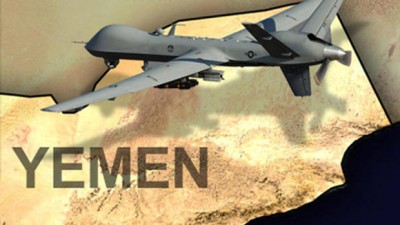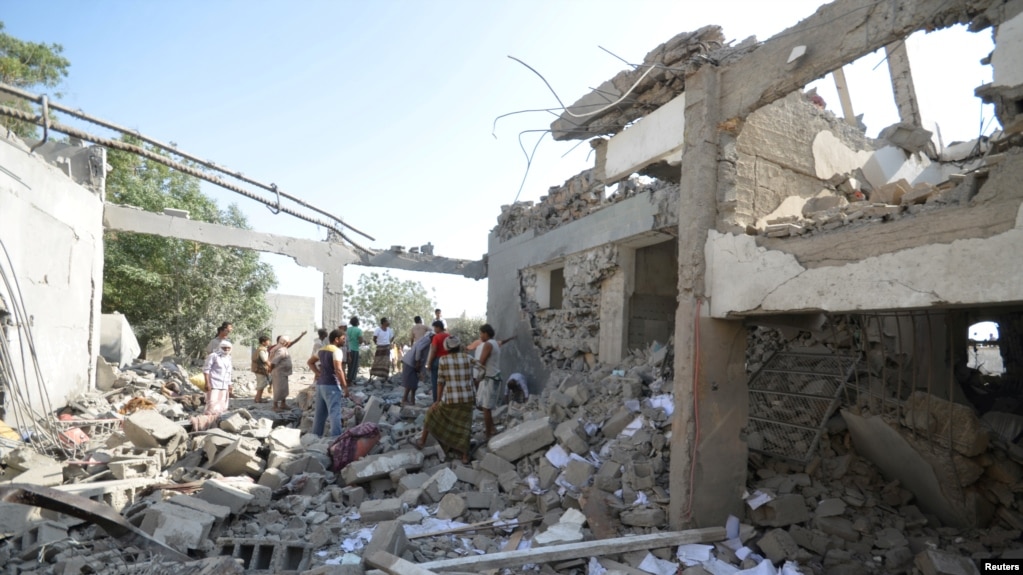Why U.S. Troops May Fight Alongside Al Qaeda in Yemen
Trump is expanding the flawed policy of Obama.

The Trump administration has indicated that it will increase its support for Saudi Arabia’s war against Yemen’s Houthi rebels.
The Saudi-led war, which began two years ago, has achieved little beyond killing thousands, destroying much of Yemen’s infrastructure, empowering al-Qaeda in the Arabian Peninsula (AQAP), and pushing millions to the brink of famine. The war is being waged with few ethical constraints: Saudi Arabia has targeted funerals, schools, factories, and farms. Most recently, a boat full of refugees fleeing Yemen was attacked by an Apache helicopter. That attack killed 42 people.
The war has shown Saudi Arabia’s lavishly funded armed forces to be a paper tiger that is incapable of even defending the country’s southern border with Yemen. Now that the Saudis and their chief ally, the United Arab Emirates, have failed to defeat the Houthis, who are allied with much of the Yemeni Army, they want more support from Washington.
The excuse being given for increased U.S. involvement in an incredibly complex civil war is that the Houthis are controlled and armed by Iran. This is a narrative that has been in play for years despite little proof of consistent Iranian support for the Houthis and no proof that the Houthis follow Iranian orders.
Most recently, U.S. and international media have cited reports prepared by a UK-registered company called Conflict Armament Research (CAR). Their thin reports offer limited evidence of Iranian arms transfers and rely heavily on sources from within the armed forces of the United Arab Emirates—hardly a disinterested party. CAR’s March 2016 report on purported small-arms shipments from Iran to Yemen included a map that showed the weapons shipments transiting southern Yemen. Yet southern Yemen is controlled by anti-Houthi forces and AQAP, not the Houthis.
The latest CAR report, which is also largely based on sources from within those forces opposing the Houthis, claims that Iranian-made drones are being smuggled via Oman to the Houthis and allied forces. The government of Oman has remained neutral throughout the conflict and has consistently backed a negotiated settlement to the war in Yemen. It is unlikely that Oman would allow Iranian-made drones to be shipped into—and then out of—the country. Like its army, Oman’s intelligence services are highly capable.

While there is little doubt that Iran has—at times—provided limited assistance to the Houthis, there remains scant evidence of a concerted effort by Iran to arm and fund the Houthis. It most certainly exercises no control over them. What these reports and most of the international media studiously ignore is the tremendous amount of light and heavy weaponry that Saudi Arabia and the UAE have sent and are continuing to send to Yemen, ostensibly to arm anti-Houthi militias.
These weapons include everything from assault rifles—some of which now cost less than 30 kilos of rice in Yemen’s thriving arms markets—to anti-tank guided missiles (ATGMs), which are being provided to what are in most cases poorly vetted militias.
The lines between anti-Houthi forces and AQAP are far from distinct. In what is a clear parallel with Syria, many of these militias have been infiltrated by al-Qaeda operatives. The largely southern-based militias backed by Saudi Arabia are often poorly trained and poorly paid, if they are paid at all. In contrast, AQAP’s operatives are battle hardened, well-equipped, and well-paid. AQAP—far more than the Houthis—has benefited from the influx of weapons to Yemen. AQAP is leveraging its access to weaponry along with the superior skills of its fighters to overtly and covertly infiltrate many of the forces that are fighting the Houthis. Over the past two years, they have made themselves indispensable in fiercely contested frontline areas like al-Bayda and Taiz.
AQAP’s fighters will play a role in the coming battle for the Yemeni port city of Hodeidah. The port, which is controlled by the Houthis, is the lifeline for northwest Yemen. Yemen imports in excess of 90 percent of its food. Before the war, as much as 70 percent of Yemen’s imports passed through Hodeidah. Recognizing this, Saudi Arabia bombed the port and destroyed its cranes. Despite the bombing of the port and Saudi Arabia’s naval blockade, desperately needed humanitarian supplies and food continue to trickle in through the port.
Seizing the port of Hodeidah would allow Saudi Arabia to tighten its grip on the country by starving much of the population into submission. However, Saudi and Emirati forces are incapable of seizing the port on their own. They have tried and failed. They need the help of the U.S., and it looks like they will get it, perhaps in the form of limited numbers of American troops. With U.S. support, Saudi Arabia may well be able to capture Hodeidah. Yet the real question is: what comes next? In those parts of Yemen that Saudi and Emirati forces claim to have liberated, there is no real functioning government. In many areas, AQAP has filled the void.
 What is certain is that the battle for Hodeidah will not be the end of the war in Yemen. It will be just the beginning of a new and far more deadly chapter for all involved—most especially the thousands of Yemeni civilians who are watching their children slowly starve to death. The Houthis and the Yemeni Army units allied with them will fight on. Taking Hodeidah, which is likely to be a costly battle, will be easy compared with the long march up into Yemen’s rugged mountains and canyons, which favor defensive warfare.
What is certain is that the battle for Hodeidah will not be the end of the war in Yemen. It will be just the beginning of a new and far more deadly chapter for all involved—most especially the thousands of Yemeni civilians who are watching their children slowly starve to death. The Houthis and the Yemeni Army units allied with them will fight on. Taking Hodeidah, which is likely to be a costly battle, will be easy compared with the long march up into Yemen’s rugged mountains and canyons, which favor defensive warfare.
Ironically, the Trump administration’s narrow focus on checking Iran may well draw the U.S. further into a war in which the two beneficiaries are Iran and AQAP. Currently, Iran has little influence with the Houthis, who are distinctly Yemeni and deeply rooted in a very Yemeni socio-cultural context. However, that may change if the U.S. deepens its involvement in Yemen. Regardless, Iran can only be delighted by the fact that Saudi Arabia is mired in a conflict that is draining it of funds and has shown the very real limitations of its armed forces. The war in Yemen—which is unpopular with much of the Saudi population and with some members of the Saudi royal family—also threatens to sow discord in Saudi Arabia itself. This is truly frightening given the prospect of what kind of regime might replace the House of Saud.
AQAP, which has already been greatly aided by the war in Yemen, will also benefit from increased U.S. involvement. It will profit from the weakening of the Houthis—AQAP’s most formidable enemy—and from the perception, which it will foster, that the U.S. is invading Yemen. The American drone campaign in Yemen already serves this purpose. AQAP acknowledges that the use of drones by the U.S. is its greatest recruitment tool. U.S. troops on the ground in Yemen, if it comes to that, will be an even greater boon to AQAP’s recruitment efforts.
By doubling down on the deeply flawed policy put in place by the Obama administration, the Trump administration is serving the interests of AQAP and hardliners in Iran. Rather than aiding Saudi Arabia, the Trump administration should work toward a path that would enable Saudi Arabia to withdraw from Yemen while saving face. This might allow negotiations between Yemen’s warring parties to begin anew. Such a policy is far more likely to check AQAP and Iranian ambitions than increasing U.S. involvement in yet another costly war.
Michael Horton is a senior analyst for Arabian affairs at the Jamestown Foundation. He is a frequent contributor to Jane’s Intelligence Review and has written for numerous other publications including The National Interest, The Economist, and West Point’s CTC Sentinel.

